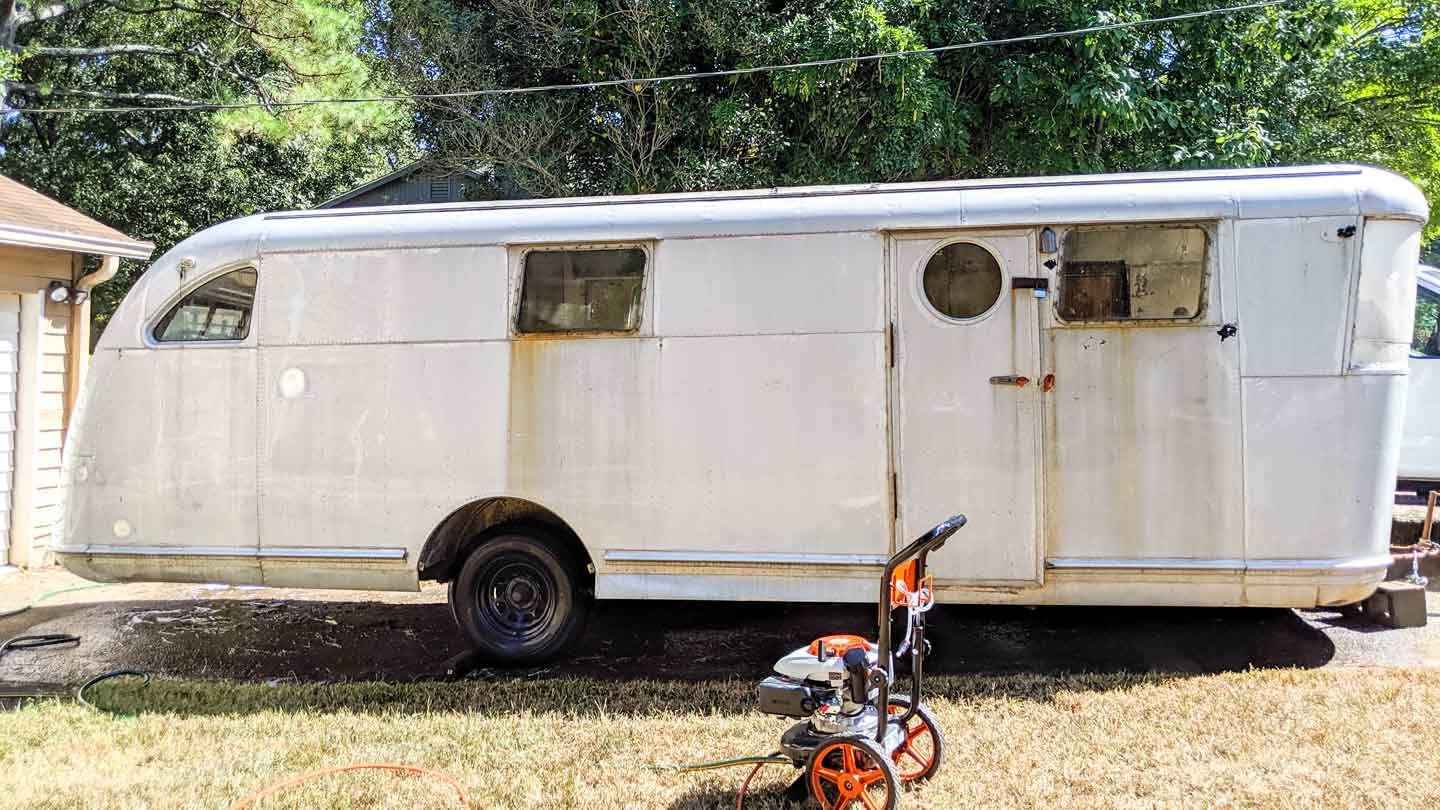
Your RV or camper is your home on the road—but it also takes a beating from the elements. Dirt, bugs, bird droppings, tree sap, mold, and road grime build up fast. And while it’s tempting to blast all that gunk off with a pressure washer, doing it the wrong way can damage seals, paint, vents, or worse—your RV’s roof membrane.
In this guide, you’ll learn how to safely and effectively pressure wash your camper or RV, so it looks great and stays road-trip ready. 🏕️🚿
🧭 Why Pressure Wash an RV or Camper?
RVs and campers collect:
- Bug splatter on the front cap and mirrors
- Road grime along the undercarriage and lower panels
- Tree sap and pollen from campgrounds
- Black streaks from oxidation and runoff
- Bird droppings and mildew on the roof and awnings
Cleaning not only keeps your rig looking sharp—it protects it from long-term damage and helps maintain resale value.
🧰 What You’ll Need
- Pressure washer (1,200–2,000 PSI max)
- 25° and 40° nozzle tips
- Telescoping wand or RV extension wand
- RV-safe soap or mild vehicle detergent
- Soft-bristle brush or RV brush head
- Bucket and sponge
- Ladder (for roof work)
- Safety gear (gloves, goggles, nonslip shoes) 🥾🧤
- Optional: Foam cannon for even soap coverage
💡 Never use a zero-degree nozzle—it’s too powerful and may damage seams, decals, or vents.
Browse Amazon Here For Top Rated Power Washers And Accessories
🛠️ Step-by-Step: How to Pressure Wash an RV Safely
1️⃣ Prep the Area and Vehicle
- Park your RV on level ground with good drainage
- Retract the awning, close all windows and doors
- Cover vents, delicate decals, or solar panels with painter’s tape or plastic
- Disconnect power or propane if necessary
2️⃣ Rinse Off Loose Dirt
Using a 40° fan nozzle at low pressure:
- Start from the top down
- Rinse all four sides, tires, undercarriage, and front cap
- Spray in long, overlapping passes
- Avoid spraying directly into seals, vents, or rooftop appliances
This removes the majority of dust and grime so your soap can work better.
3️⃣ Apply Soap or Detergent
Use a foam cannon or the detergent function of your washer:
- Spray the RV in sections (roof, sides, back, front)
- Let the soap sit for 5–10 minutes, but don’t let it dry
- For stubborn areas like the front cap or bug splatter, use a bug and tar remover
🚫 Avoid household cleaners or bleach—they can damage paint and rubber seals.
4️⃣ Scrub as Needed
Use a soft RV-safe brush or microfiber mitt:
- Focus on black streaks, mildew spots, and heavy bug residue
- Use an extension pole to reach higher areas without getting on the roof
Scrubbing helps loosen any buildup that soap and pressure alone won’t remove.
5️⃣ Rinse Completely
Switch back to a 25° or 40° nozzle:
- Rinse off all soap residue
- Use consistent top-to-bottom motion
- Be gentle near edges, trim, vents, and decals
Pay extra attention to awning arms, door handles, mirrors, and trim where water can pool.
🧼 Roof-Specific Tips
RV roofs are commonly made from rubber (EPDM or TPO), fiberglass, or aluminum:
- Use low pressure (under 1,500 PSI)
- Don’t spray directly into A/C units or roof seams
- Use a ladder and handheld wand instead of walking on the roof
- Apply a roof cleaner with a soft brush if heavily soiled
⚠️ Leaks from roof damage can cost thousands—be extra cautious.
❌ Common Mistakes to Avoid
- ❌ Using too much pressure near windows, doors, or seams
- ❌ Spraying directly into refrigerator vents or water heater exhausts
- ❌ Skipping soap or using dish detergent
- ❌ Spraying decals too closely—can cause peeling
- ❌ Washing in full sun—leads to streaking and soap spots
🌎 Eco-Friendly Options
- Use biodegradable RV soaps
- Wash over gravel or grass—not near storm drains
- Minimize water waste by using a low-GPM washer
- Consider using gray water collection mats at campgrounds that require them
🗓️ Suggested Cleaning Schedule
| RV Part | Frequency |
|---|---|
| Exterior wash | Every 4–6 weeks or after trips |
| Roof cleaning | 2–3 times per year |
| Awning rinse | Monthly (or after tree exposure) |
| Undercarriage | After driving on salted or muddy roads |
🧽 Add-On Areas to Clean
While you’re at it, consider pressure washing:
- RV steps and running boards
- Tow hitch and bumper
- Tire rims and wheel wells
- Utility compartments and storage bay doors
- Generator housing (carefully)
💬 Final Thoughts
Cleaning your camper or RV with a pressure washer isn’t just about looks—it’s about protecting your investment and ensuring everything functions properly on the road.
By sticking to safe pressure levels, using the right nozzles and soaps, and taking care around sensitive areas, you’ll keep your rig sparkling clean and ready for the next adventure. 🏞️✨
Whether you’re a weekend warrior or full-time RVer, a clean exterior makes every journey feel fresh and well-prepared. 🚐🧼🌟
Browse Amazon Here For Top Rated Power Washers And Accessories



